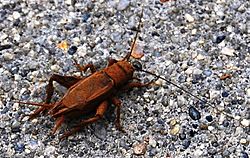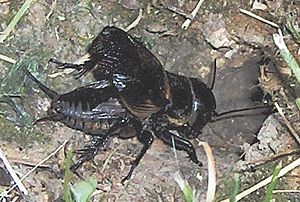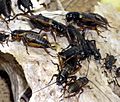Cricket (insect) facts for kids
Quick facts for kids Cricket |
|
|---|---|
 |
|
| A cricket | |
| Scientific classification | |
| Kingdom: | |
| Phylum: | |
| Class: | |
| Order: | |
| Suborder: | |
| Superfamily: |
Grylloidea
|
| Family: |
Gryllidae
Bolívar, 1878
|
Crickets are fascinating insects known for their unique chirping sounds! They belong to the family Gryllidae, often called "true crickets." These little creatures are cousins to grasshoppers and even closer relatives to katydids. Crickets have flat bodies and long antennae. There are around 900 different species of crickets found worldwide.
Crickets are usually active at night, which means they are nocturnal. People sometimes confuse them with grasshoppers because they both have strong back legs for jumping. Like all insects, crickets are cold-blooded. This means their body temperature changes to match the temperature of their surroundings.
Contents
How Crickets Chirp
Crickets are famous for their chirping, but only male crickets can do it! Male crickets have special parts on their wings that work like a "comb and file" instrument. Their left front wing has a thick ridge with 50 to 300 tiny "teeth." To chirp, a male cricket lifts his left front wing to a 45-degree angle. Then, he rubs it against the upper edge of his right front wing, which has a thick scraper. This action is called "stridulation." Each cricket species has its own unique song.
There are two main types of cricket songs:
- Calling song: This song is quite loud. It helps male crickets attract female crickets. It also tells other male crickets to stay away.
- Courting song: When a female cricket is nearby, the male will sing a very quiet song. This special song is used to impress her.
To hear other crickets, a cricket has ears located on its knees! These tiny ears are just below the joint of their front legs. Crickets chirp at different speeds depending on their species and the temperature around them. Most species chirp faster when the temperature is warmer.
Ancient Cricket Songs
Scientists have even figured out what night-time sounded like 165 million years ago, during the Jurassic period! They reconstructed the song of an ancient bush cricket. A very well-preserved fossil of this prehistoric insect helped them see the wing structures. These were the parts that rubbed together to make sound.
Cricket Diet and Life
Crickets are omnivores, which means they eat both plants and other things. They feed on organic materials, like decaying plant matter and fungi. They also enjoy eating some young plants called seedlings. Crickets have strong jaws. They can sometimes bite humans, but usually, their bite doesn't break the skin. However, it can feel a bit painful on sensitive skin, like the skin between your fingers.
Crickets usually mate in late summer. Female crickets then lay their eggs in the fall. The eggs hatch in the spring. A fertile female can lay as many as 2,000 eggs! However, some types, like the Acheta Domestica, lay eggs almost all the time. Females of this species can lay eggs at least twice a month. Female crickets have a long, needle-like organ called an ovipositor. They use this to lay their eggs.
Crickets are also a popular food source for many animals. They are often fed to pets like frogs, lizards, salamanders, and spiders.
Crickets in Culture
Crickets are popular pets in many parts of the world. In Asia, especially China, people often keep them in small cages. Crickets are even considered good luck there! It's also common to keep them as pets in some European countries.
In some parts of Asia, people enjoy Cricket fighting. This can be a form of gambling or a sports betting pastime.
In American comedy, the sound of crickets is sometimes used for humor. If a comedian tells a bad joke on a TV show, and no one laughs, you might hear the sound of crickets chirping. This means there's an awkward silence when laughter was expected.
Images for kids
-
Different stages of Gryllus assimilis, drawn by Robert Evans Snodgrass, 1930
-
A fossil cricket from the Cretaceous period in Brazil.
-
Il Grillo Parlante (The Talking Cricket) illustrated by Enrico Mazzanti for Carlo Collodi's 1883 children's book "Le avventure di Pinocchio" (The Adventures of Pinocchio)
-
Illustration for Charles Dickens's 1883 Cricket on the Hearth by Fred Barnard
-
A Meiji period cricket holder shaped like a norimono palanquin, from around 1850.












